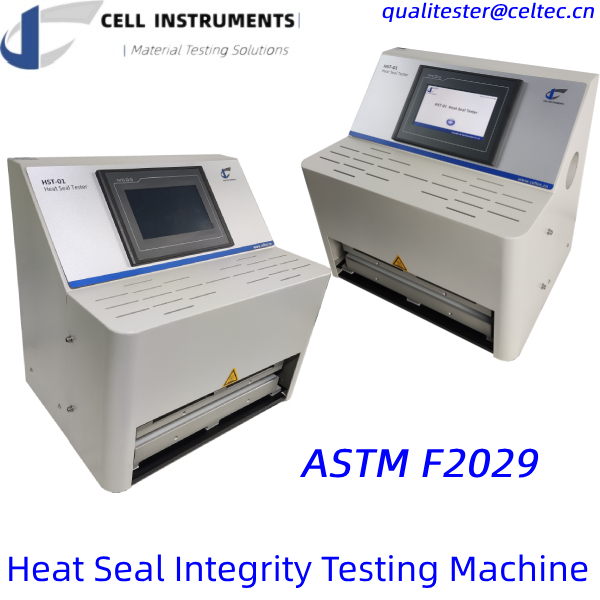Introduction
Heat seal integrity testing is a critical process in ensuring the quality and safety of packaging, particularly in industries such as food, medical devices, and pharmaceuticals. The integrity of a heat seal can determine the effectiveness of a package in protecting its contents from contamination, spoilage, or damage. Adhering to the ASTM F2029 standard is essential for producing consistent and reliable results in heat seal testing. In this article, we will explore the importance of heat seal integrity testing, discuss key methods, and provide insights into how compliance with ASTM F2029 ensures the reliability of your products.

Understanding Heat Seal Integrity Testing
Heat seal integrity testing involves assessing the strength and uniformity of heat seals in flexible packaging materials. These seals are typically formed by applying heat and pressure to bond materials together. The integrity of these seals is paramount, as any weakness can compromise the package, leading to product failure.
The Role of ASTM F2029 in Heat Seal Testing
ASTM F2029 is the Standard Test Method for Making Heat Seals for Determination of Heatsealability of Flexible Webs as Measured by Seal Strength. This standard provides guidelines for creating and evaluating heat seals, ensuring that the testing process is consistent and the results are reliable. Compliance with ASTM F2029 is crucial for manufacturers who aim to meet industry standards and maintain the quality of their products.
Key Aspects of Heat Seal Integrity Testing
- Seal Strength The primary focus of heat seal integrity testing is to measure the strength of the seal. This involves pulling the sealed material apart using a tensile testing machine and recording the force required to break the seal. The result provides a quantitative measure of the seal’s strength, indicating its reliability in protecting the contents.
- Seal Uniformity Seal uniformity is another important factor. A uniform seal ensures that there are no weak spots that could lead to seal failure. Testing for uniformity involves evaluating the consistency of the seal across the entire length of the material.
- Seal Appearance The visual quality of the seal is also examined. Defects such as bubbles, wrinkles, or incomplete seals can indicate poor seal integrity. A good seal should be smooth and free from any visible defects.
Conducting Heat Seal Integrity Testing
-
Preparation of Test Specimens
- Samples of the material are prepared to specific dimensions, ensuring uniformity.
- Samples must be free from defects and contaminants that could affect seal quality.
-
Setting Test Parameters
- Appropriate temperature, pressure, and dwell time settings are selected based on the material.
- These parameters are documented for consistency and reproducibility.
-
Conducting the Test
- The sample is placed between the heated sealing bars.
- Pressure is applied and held for the designated dwell time.
- The sample is then removed and allowed to cool before further analysis.
-
Measuring Seal Strength
- A tensile testing machine is used to pull the sealed sample apart.
- The force required to break the seal is measured and recorded.
Applications of Heat Seal Integrity Testing
Heat seal integrity testing is vital in various industries to ensure the safety and quality of products:
- Packaging Industry: Testing heat seals in packaging materials helps maintain product freshness and safety.
- Medical Devices: Verifying heat seals in sterile packaging is crucial for preventing contamination and ensuring patient safety.
- Pharmaceuticals: Ensuring the integrity of heat seals in pharmaceutical packaging is essential for product safety and regulatory compliance.
- Textiles: Testing heat-sealable fabrics used in technical textiles and garments ensures product durability.
Why Choose Cell Instruments for Heat Seal Integrity Testing?
Cell Instruments offers advanced heat seal testers that are designed to meet the rigorous standards of ASTM F2029. Our heat seal testers provide precise and reliable results, making them an essential tool for any industry requiring high-quality heat seals. With customizable options and automation capabilities, our testers can be tailored to meet specific testing needs, ensuring that your products meet the highest standards of quality and safety.
FAQ
- What is heat seal integrity testing?
- Heat seal integrity testing evaluates the strength and consistency of heat seals in packaging materials to ensure they can protect the contents effectively.
- Why is ASTM F2029 important in heat seal testing?
- ASTM F2029 provides standardized methods for making and evaluating heat seals, ensuring consistent and reliable results in testing.
- How does a heat seal tester work?
- A heat seal tester applies heat and pressure to bond materials together, and then measures the strength of the seal by pulling the materials apart.
- What industries require heat seal integrity testing?
- Industries such as packaging, medical devices, pharmaceuticals, and textiles require heat seal integrity testing to ensure product safety and quality.
- Can heat seal testers be customized?
- Yes, Cell Instruments offers customization options for heat seal testers to accommodate specific testing protocols or material specifications.
Related Products
Related Article
Heat Seal Strength Test Method
Polyethylene Heat Seal Temperature
Seal Strength of Plastic Films
Heat Seal Equipment for Laboratory Testing
Laboratory Heat Sealer for Film Testing
Plastic Film Heat Seal Testing
